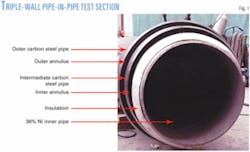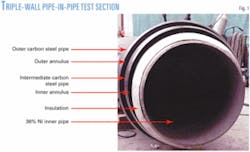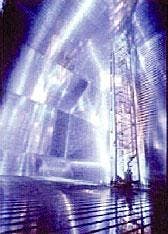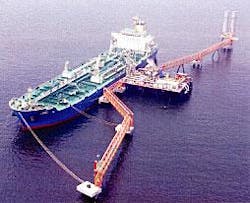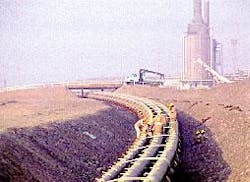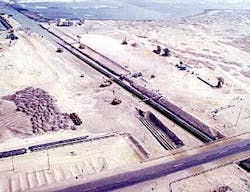The large number of proposed LNG projects currently vying for public and governmental approval on a global basis has led to an increased focus on associated safety, economic, environmental, and aesthetic issues. LNG project teams will consider designing LNG terminals using subsea or buried onshore LNG pipelines in an effort to offer safe, robust, cost-effective, and environmentally and visually appealing alternatives to more traditional technology.
AMEC Paragon used this approach for the Camisea LPG export terminal offshore Peru. Using InTerPipe’s (ITP) subsea cryogenic pipeline system, AMEC Paragon proposed a marine export terminal design that allowed the client (Pluspetrol SA, Buenos Aires) to obtain critical local approval for the project. This article discusses the technical, economic, safety, and local acceptance advantages of a terminal based on subsea or buried onshore LNG pipelines.
Public scrutiny
LNG projects face significant public scrutiny worldwide. Local populations object to real and perceived safety, environmental, and inconvenience aspects of siting an LNG facility in their communities. In siting LNG terminals and dealing with the public, potential developers need to be reminded of the basic equation developed by Peter Sandman, a pre-eminent risk communication consultant:
Risk = Hazard + Outrage.
“Hazard” is the technical risk engineers are trained to assess. “Outrage” is the public’s perception of risk. “Outrage” is made up of factors such as trust, responsiveness, control, etc. Clearly, with the difficulties experienced by the developers of some projects in obtaining local approval, a successful approach must balance technical and economic feasibility with political realities specific to each location. For each project, the “Outrage” factor of the risk equation must be managed as effectively as the “Hazard” factor.
Alternative technology
It is technically and economically feasible to transport cryogenic fluids (including LNG and LPG) at typical loading-offloading rates (10,000 cu m/hr) over relatively long distances (~10 miles) via straightforward, robust pipe-in-pipe loading lines. This feasibility provides wider options for siting an LNG terminal than had previously been available.
For projects where there is strong public concern about LNG carriers approaching residential areas, the berth can be moved further offshore. The LNG might also move via pipeline from a berth to an inland location where siting LNG tanks is more acceptable, or to a facility which has waste heat for regasification (refinery, alumina plant, etc.).
While double-wall and triple-wall pipe-in-pipe options are both thermally and mechanically feasible using ITP’s LNG pipe technology, we have chosen to describe the triple-wall option. Fig. 1 shows a cross-section of the triple-wall pipe.
This design has an inner pipe made of 36% nickel steel, microporous insulation, an intermediate carbon steel pipe, and an outer carbon steel pipe. The third pipe outer wall is optional but adds an extra level of mechanical integrity.
The ability to employ butt welds-which are both robust and easily inspected-for all girth welds between individual field joints makes pipeline transport of LNG significantly more feasible. Additionally since the mechanical properties of ITP’s Izoflex insulation make it safe to weld directly over it the field joints are insulated in exactly the same manner as the running pipe, eliminating any cold spots.
Elimination of expansion loops or bellows, which are typically required to accommodate the expansion and contraction caused by low operating temperatures (-256° F.), also increases both the robustness of the design and the feasibility of this approach. Using the 36% nickel steel inner pipe in the pipe-in-pipe design allows the expansion loops to be eliminated.
The high thermal performance of the ITP insulation system also allows for a compact pipe-in-pipe configuration.
Pipe-in-pipe technology
The upstream oil and gas industry has used pipe-in-pipe flowlines for three decades to improve thermal performance. Quest Offshore Resources Inc. reports almost 400 miles of pipe-in-pipe installed for upstream oil and gas projects between 2000 and 2004. Lay barges using J-lay, S-lay, reeled, or towed equipment weld and install these pipes in water depths exceeding 5,000 ft.
ITP’s technology uses the same DNV design code (DNV OS-F101 Submarine Pipeline System) employed for oil and gas pipe-in-pipe installations.
High-performance insulation
Another important, field-proven component of the ITP LNG pipeline is ITP’s Izoflex insulation. It is a microporous insulation. Unlike other solid insulation materials, microporous insulation has a thermal conductivity lower than the thermal conductivity of still air. Izoflex have been installed in subsea oil and gas pipelines since 1998. Currently 105 miles of installed ITP subsea pipe-in-pipe line has this insulation. An additional 40 miles will be installed in 2006 offshore Angola.
Izoflex insulation is installed and operational at -54° F. for the cryogenic LPG pipelines at the Camisea project. Its performance was confirmed in service at Camisea, as well as at LNG temperatures (-256° F.) during a joint industry project at Gaz de France. Its capabilities have also been demonstrated at liquid nitrogen temperatures (-320° F.).
This degree of thermal efficiency allows cryogenic pipelines to operate with little temperature rise (heat gain) during loading and offloading. In fact, most of the heat gain in the loading operation comes from the loading pumps. During a shutdown, the pipelines can remain at operating temperature for almost 25 days without recirculation.
Izoflex insulation consists of silica and titanium dioxide. It is not subject to thermal aging, since there are no organic components. The thermal conductivity of the insulation is 0.005 w/m-K in the as installed condition, with all fabrication tolerances for cryogenic applications. Izoflex can be used over temperature ranges of -320° F. to 1,600° F., allowing for welding directly on top of the insulation, which greatly facilitates the ease of pipeline fabrication. The insulation has good mechanical compressive properties, eliminating the need for centralizers within the pipe-in-pipe annulus.
Thermal expansion steel
A specialized alloy, 36% nickel steel has been used since 1968 as the membrane for LNG carriers because of its unique thermal and mechanical properties. It exhibits the least amount of thermal expansion of any alloy. The coefficient of thermal expansion of 36% nickel steel is 10 times less than that of the typical stainless steel used for cryogenic applications.
A total of 69 LNG carriers were built with 36% nickel steel membranes from 1968 through 2005. Fig. 2 shows the membrane of an LNG carrier. The use of 36% nickel steel in LNG carriers has provided extensive experience in its application and the welding specifications involved, each LNG carrier having about 120 km of welds.
A pipeline made of this material can accommodate the extreme thermal expansion and contraction effects of -256° F. LNG fluids without the need for expansion loops or bellows. Elimination of the expansion loops and bellows is a necessary requirement for subsea applications.
Large-diameter 36% nickel steel pipe was installed at the Tokyo Gas Co.’s Ohgishima LNG receiving terminal. Pipe made of the alloy is also being installed in a subsea tunnel to connect Osaka Gas’s Senboku LNG Terminal I to Senboku LNG Terminal II.
Installation techniques
Without expansion loops, the techniques required to install a buried onshore LNG pipeline are straightforward. Similarly, without the need for expansion loops, the techniques used to install a subsea LNG pipeline are time-proven. Tow methods-fabricating the pipeline on site into long segments, perhaps even the complete subsea length, and then pulling the pipe strings offshore along the pipeline route-have been used in the upstream oil and gas industry for decades.
Camisea LPG
In 2002, the Camisea project selected ITP technology for the onshore and subsea propane and butane loading lines. Fig. 3 shows the LPG berth for Camisea at Pisco, Peru. What is noticeably absent in the picture are butane and propane pipelines. The conventional trestle originally proposed for this project was the victim of local objections. These objections were based on the high visibility of such lines and concern that a trestle would interfere with fishing boat routes. The trestle was also subject to a risk of collision over the anticipated 35-year project life and was higher in cost than the subsea option.
In the end, two 20-in. × 24-in. pipe-in-pipe lines were used to transport propane and butane at temperatures as cold as -49° F. from the Pisco fractionation plant to the offshore berth; 1 km buried onshore and 3 km buried offshore.
At LPG temperatures, the inner carrier pipe can be made of carbon steel. The system provides high thermal performance while using only 20-mm thick insulation, resulting in a compact pipe-in-pipe design.
Fabrication space was set aside onsite so that the entire 3-km length of the offshore pipelines could be built onshore. The completed pipelines were placed on a railroad track and later pulled offshore as a unit. Fig. 4 shows the “flat pack” containing the two 20-in. x 24-in. pipe-in-pipes, a 24-in. naphtha line, a 10-in. diesel line, an umbilical, and a number of plastic pipes used for buoyancy. There are no cool down lines or vapor return lines. The bundle was towed in to place in only 4 days (Fig. 5).
The pipelines became operational in September 2004 when the first load of butane was shipped. Field measurements of the thermal performance of the pipe-in-pipe loading system in operation confirmed that designed thermal performance had been achieved.
While the system is designed to continuously circulate product through the cryogenic lines to keep them cold, the system’s thermal performance resulted in such a low boil-off rate that the pipelines can be shut-in between shipments for longer than a week and still maintain operating temperatures.
The Camisea LPG pipelines demonstrate all components of the LNG pipeline design, construction, and installation components except the 36% nickel steel pipe.
ITP LNG subsea
In 2003, ITP was joined by four major oil companies in a joint industry project (JIP) with the objective of qualifying ITP’s LNG pipe design for subsea transportation of LNG. The JIP successfully obtained “Approval in Principle” from the American Bureau of Shipping and “Statement of Feasibility” from Det Norske Veritas for the LNG pipe design for subsea service in 2004.
A full-scale, triple-wall test section was fabricated and tested. The test section (Fig. 1) consisted of:
• A 24-in., 36% Ni steel inner pipe with 40-mm thick insulation.
• A 30-in. carbon steel intermediate pipe.
• A 34-in. carbon steel outer pipe.
As applied in the LNG pipeline configuration, the Izoflex insulation provides an overall U-value of 0.131 w/sq m-°C.
The 18-m test section consisted of a 12-m straight section and a 5D bend, for a total 18-m length. The test section included two full-scale end bulkheads and an inline bulkhead at the base of the bend. The straight section included one 36% nickel steel girth weld. The bend demonstrated the ability to manufacture bends through an induction bending process.
The test program consisted of the following:
• A hydrostatic pressure test at 30 barg and ambient temperature
• Five thermal cycles from ambient temperature to -196° C. (-320° F.) and 1 barg, including shock cooling of the inner pipe with liquid nitrogen
• Four boil-off tests at -160° C. (-256° F.) and 17 barg, across a range of inner annulus pressure conditions.
Economics
The economics of an LNG pipeline depend on project-specific parameters. Replacing a trestle with a subsea pipeline, however, can be cost-effective. Important factors in determining the economics are:
• Required length of trestle or pipeline (longer lengths greatly favor subsea pipelines).
• The need for dredging.
• Local environmental regulations or seabed conditions that impact the cost of a trestle.
• Combining a subsea pipeline with a single-point mooring system eliminates not only a trestle, but sometimes a breakwater as well, depending on local conditions.
Potentially the most important economic factor-as it also relates to project schedule-is whether the LNG pipeline (buried onshore or offshore) can help gain local approval for the project. The Camisea project, addressed this factor in a number of ways:
• Reduced visibility of the loading system.
• Reduced potential for accidental pipeline damage, since the lines would be buried.
• Reduced impact on fishing, shipping, and recreational activities.
• Reduced accessibility for intentional pipeline damage, since the lines would be buried.
• Placement of LNG carriers further offshore.
• Placement of LNG tanks further inland, away from populated areas.✦
The authors
Richard L. Rankin ([email protected]) is vice-president of midstream projects at AMEC Paragon Inc., Houston. He has also served as vice-president of the upstream division of Foster Wheeler USA Corp., senior vice-president of hydrocarbons for Aker Kvaerner, and vice-president of projects for John Brown. A registered professional engineer in Texas, he holds a BS in mechanical engineering from Oklahoma State University, Stillwater. (1975).
M.B. Mick ([email protected]) is vice-president, deepwater and special projects, at AMEC Paragon Inc., Houston. He previously worked 25 years at Marathon Oil Co., where most recently he served as deepwater development manager. Also at Marathon, he had a distinguished career in major projects development, plus assignments as corporate HES manager, and downstream logistics. A registered professional engineer in Ohio, he holds a BS in chemical engineering from the University of Dayton in Dayton, Ohio (1967), an MS in chemical engineering from the University of Florida in Gainesville (1968) and an MBA from Texas A&M University-Kingsville (1975). He is a member of SPE and the AIChE.
